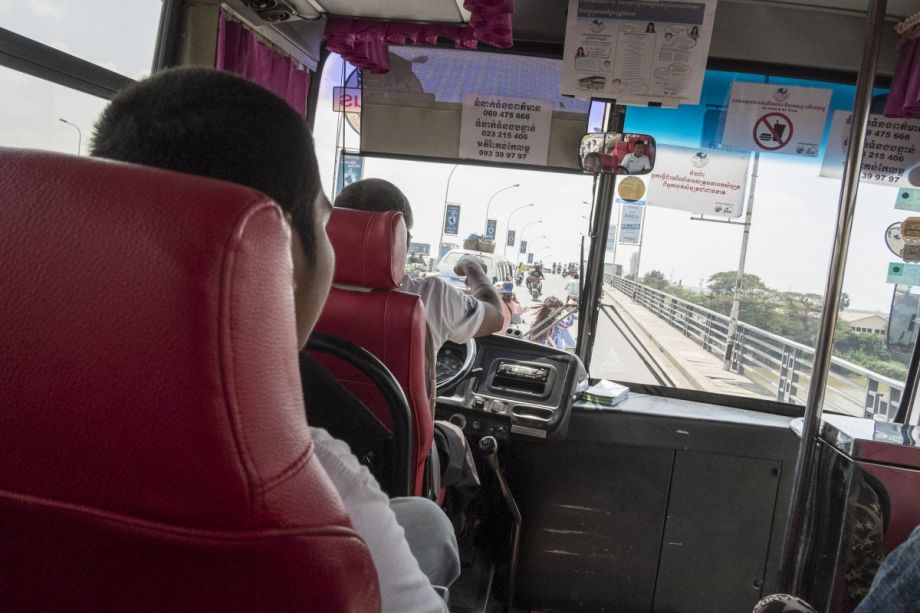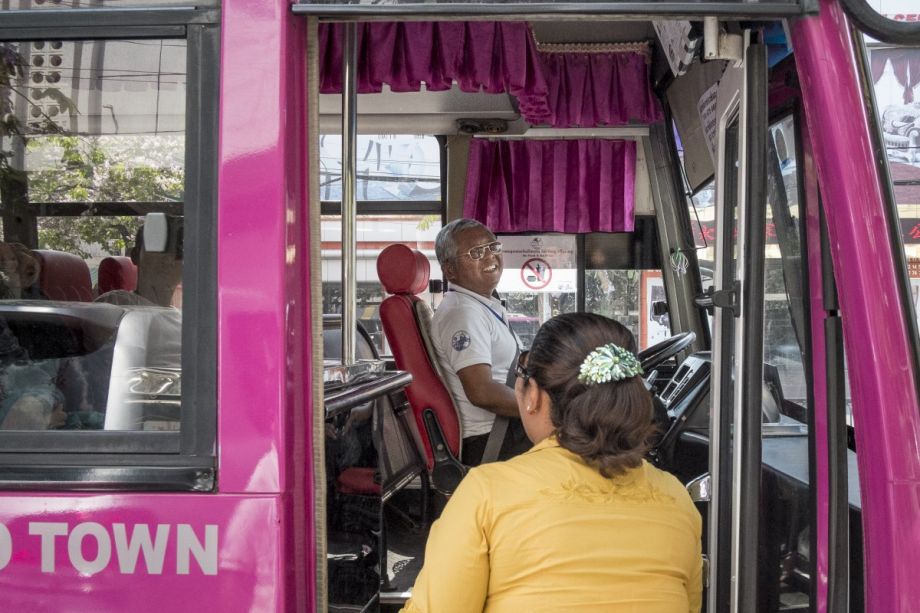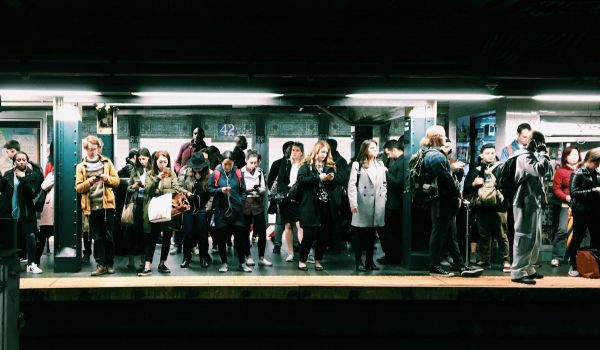Motorcycle taxis buzz around the bus as it eases past half-finished office towers, new hotels, glitzy electronics shops and restaurants signed with dancing neon crabs. When it stops, its doors open with a rush of air conditioning and a driver in gold-framed sunglasses beckons curious Cambodians into his vehicle’s vintage interior where a conductor collects a flat fare of 1,500 riel – about 40 cents.
“Before there was a bus, I would have to spend over 7,000 riel a day on motorcycle taxis, but now I’m saving money,” Lay Leung, 55, a vegetable seller in a floral pantsuit says from her vinyl seat. Above her, empty curtain hooks jangle while other passengers leaf through colorful fliers that outline the capital’s new bus service. “This is something we need more of in Cambodia.”
How much more Cambodia will get will become evident in the coming months and years. On February 5, the city of Phnom Penh and the Japan International Cooperation Agency (JICA) embarked on an experiment. For one month, a fleet of ten minibuses plied a single seven-kilometer route along Monivong Boulevard, one of Phnom Penh’s busiest commercial thoroughfares, servicing 36 stops every 10 to 15 minutes from 5:30am to 8:30pm. JICA rented the buses, paid the drivers, installed bus stop signs and covered the cost of fuel while the city of Phnom Penh provided workers to dispense information about the new system.
This was a big deal for Phnom Penh, which has no formal public transportation system. The government launched a publicity blitz with JICA-funded radio, TV and newspaper spots, and the story was picked up by local and international media. When the month-long experiment concluded on March 4, JICA and the city declared it a resounding success. More than 42,000 people had taken the bus (about 1,500 riders per day) and bus capacity averaged between 60 and 70 percent. User feedback, moreover, was overwhelmingly positive.
“A city with heavy traffic cannot function,” says JICA representative and land transport expert Egami Masahiko. “I think the transport system is a fundamental issue that needs to be addressed by the Cambodian government, because without a public transport system, Phnom Penh will not be able to survive in the ASEAN region.”
But whether the city can compete in the mass transit game remains to be seen. In 2001, a similar JICA-sponsored experiment failed, with people shirking city buses in favor of the more convenient door-to-door services provided by Phnom Penh’s chaotic but relatively effective informal network of motorcycle taxis and tuk tuks. Since then, however, the city’s population has doubled to more than two million, while the number of registered vehicles on the country’s roads has more than quintupled. With an ever increasing number of cars and SUVs in Phnom Penh, the city’s streets have never been so congested.

The buses face stiff competition from the city’s roving fleet of informal motorbike taxis and tuk tuks. Photo credit: Scott Howes
Traffic-related deaths are also on the rise, while a rash of bag-snatchings have made motorcycle taxis and open-aired tuk tuks particularly treacherous for female riders. The bus service, one can imagine, will also be particularly welcome during the dusty and hot months of March and April (it’s 96 degrees here today) as well as during Cambodia’s May to October wet season when monsoon rains and poor drainage turn the capital’s streets into slow-moving rivers.
According to Egami, however, buses alone cannot solve Phnom Penh’s traffic woes. So JICA and Cambodian officials have drafted a 2035 urban transport master plan for the city that includes expanded bus routes, widened streets and the introduction of an urban rail system in 2020. And for now, the bus service will continue. In typical Cambodian government fashion, however, city hall awarded the concession to a Chinese firm in a backroom deal, much to consternation of more than half a dozen other bidders. Although no contract was signed, city hall claims that the company has pledged to invest some $12 million in the project over the next five years. Amidst a barrage of criticism, Phnom Penh’s governor issued a statement saying that the company was the only bidder that offered to run the bus system without government subsidies.
According to city officials, Global (Cambodia) Trade Development – which also began running the city’s first metered taxi service in 2008 – has agreed to continue the existing service as is for another month. If all goes according to plan, three other routes will be navigating the city’s clogged streets by the beginning of June, with newer two-door buses introduced in the interim. JICA, which hopes to see a total of eight to ten routes in operation by the end of the year, is somewhat skeptical of city hall’s current arrangement.
“There are two main challenges for continuing this system: one is cost, and the other is reliability” says JICA’s Egami. “Public transport systems bring broad benefits to everyone in a city, so passengers should not have to cover the whole cost of the investment – there must be strong commitment and investment from the public… A public-private partnership is the best option when introducing new systems like these.”
Masahiko’s opinion is shared by Columbia University urban planning professor Dr. David King.
“For whatever reason, public transit just doesn’t work very well as a money-making enterprise,” says King. “If it could work as a for-profit private operation, someone would most likely have done it already… It very well may be that the company that’s saying they will do it privately now is just hoping to prove that the system is popular before they come hat in hand asking for a subsidy.”
According to King, political will is also a major obstacle in making such systems viable in the developing world. “The politicians who need to be in charge of these projects are often drivers themselves, in which case they’re less likely to support transit at the expense of driving. Also, will the motorcycle taxis and tuk tuks try to sabotage the bus service? Often, in some of the places I’ve worked in the U.S. – and I’ve heard of this happening in other cities around the world – when a new transportation system is put in, the existing operators will do what they can to ensure that it’s not a success.”
While motorcycle taxi drivers, who are able to weave through congested streets with ease, don’t feel threatened by an onslaught of ponderous buses, tuk tuk drivers like Cheang Mon are concerned about their future livelihood.
“I think the bus system is good for Cambodia, but not for tuk tuk drivers,” says the 26 year old. For the past four years, he has supported his mother, sister, wife and two children on his earnings. “We don’t go faster than the bus, and some tuk tuk drivers charge high rates… especially for foreigners. I’m worried this will hurt my business.”
Overall, however, most Phnom Penh residents welcome the new service.
“Every growing city needs a public transportation system,” says Pen Sereypagna, a young urban researcher and freelance architect. “If the bus system is expanded as part of a broader master plan, I think it will work for Phnom Penh. If not, I think it will fail. Right now, however, it’s still easier and faster for me to travel by motorbike.”
With additional reporting from Amelia Woodside







_600_350_80_s_c1.jpg)









